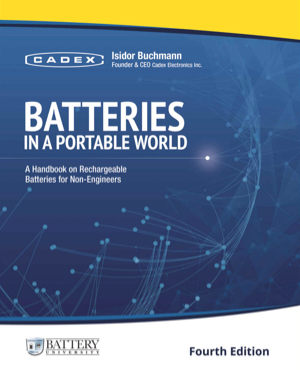Batteries can be charged manually with a power supply featuring user-adjustable voltage and current limiting. I stress manual because charging needs the know-how and can never be left unattended; charge termination is not automated. Because of difficulties in detecting full charge with nickel-based batteries, I recommend charging only lead and lithium-based batteries manually.
Lead Acid
Before connecting the battery, calculate the charge voltage according to the number of cells in series, and then set the desired voltage and current limit. To charge a 12-volt lead acid battery (six cells) to a voltage limit of 2.40V, set the voltage to 14.40V (6 x 2.40). Select the charge current according to battery size. For lead acid, this is between 10 and 30 percent of the rated capacity. A 10Ah battery at 30 percent charges at about 3A; the percentage can be lower. An 80Ah starter battery may charge at 8A. (A 10 percent charge rate is equal to 0.1C.)
Observe the battery temperature, voltage and current during charge. Charge only at ambient temperatures in a well-ventilated room. Once the battery is fully charged and the current has dropped to 3 percent of the rated Ah, the charge is completed. Disconnect the charge. Also disconnect the charge after 16–24 hours if the current has bottomed out and cannot go lower; high self-discharge (soft electrical short) can prevent the battery from reaching the low saturation level. If you need float charge for operational readiness, lower the charge voltage to about 2.25V/cell.
You can also use the power supply to equalize a lead acid battery by setting the charge voltage 10 percent higher than recommended. The time in overcharge is critical and must be carefully observed. (See BU-404: What is Equalizing Charge)
A power supply can also reverse sulfation. Set the charge voltage above the recommended level, adjust the current limiting to the lowest practical value and observe the battery voltage. A totally sulfated lead acid may draw very little current at first and as the sulfation layer dissolves, the current will gradually increase. Elevating the temperature and placing the battery on an ultrasound vibrator may also help in the process. If the battery does not accept a charge after 24 hours, restoration is unlikely. (See BU-804b: Sulfation and How to Prevent it)
Lithium-ion
Lithium-ion charges similarly to lead acid and you can also use the power supply but exercise extra caution. Check the full charge voltage, which is commonly 4.20V/cell, and set the threshold accordingly. Make certain that none of the cells connected in series exceeds this voltage. (The protection circuit in a commercial pack does this.) Full charge is reached when the cell(s) reach 4.20V/cell voltage and the current drops to 3 percent of the rated current, or has bottomed out and cannot go down further. Once fully charged, disconnect the battery. Never allow a cell to dwell at 4.20V for more than a few hours. (See BU-409: Charging Lithium-ion)
Please note that not all Li-ion batteries charge to the voltage threshold of 4.20V/cell. Lithium iron phosphate typically charges to the cut-off voltage of 3.65V/cell and lithium-titanate to 2.85V/cell. Some Energy Cells may accept 4.30V/cell and higher. It is important to observe these voltage limits. (See BU-205: Types of Lithium-ion)
NiCd and NiMH
Charging nickel-based batteries with a power supply is challenging because the full-charge detection is rooted in a voltage signature that varies with the applied charge current. If you must charge NiCd and NiMH with a regulated power supply, use the temperature rise on a 0.3–1C rapid charge as an indication of full charge. When charging at a low current, estimate the level of remaining charge and calculate the charge time. An empty 2Ah NiMH will charge in about 3 hours at 750–1,000mA. The trickle charge, also known as maintenance charge, must be reduced to 0.05C. (See BU-407: Charging Nickel-cadmium; BU-408: Charging Nickel-metal-hydride)

Comments
Hi, I have a charging case to charge lipo batteries. the maximum charge rate is 2 x 10 amps. it can charge 3s @m11.5 volt upto 6s at 22.5 volt. It's got 2 x 750 watt P.S.U.'s it. I have been trying to find out when connected to the mains power (240volt) how many watts does it draw. I have a 2.5 kw generater to use at the field however it's too heavy for me at 27kg, will a honda 1000 watt be suffice? I have always wanted to know how to work out how much current a battery charger draws from the mains (240 volt) @ X amps. whats the formula? thanks
I have a pair of DuraCell SLI31DTMAGM Marine Batteries. The 20 hour rate is 105 AHr. The CCA rating is 800A. According to BU-403, the actual C-Rate is 20 X 105 AHr = 2100 AHr. Is that correct? Above, the recommendation is to charge at a 0.3C rate or 630 Amps. Is this correct? I have a Xantrex 20CT charger (20 Amps/ 3 outputs). Is this adequate for my batteries?
Thanks,
Greg
Looking for comments from the previous website?
Comments from the previous website are not compatible with our new commenting system but we have preserved them so our users can still reference and make use the information in them.

I have a 240 /15v conversion to charge a 250ah battery, Battery in garage is only charging 8.8 v . checked that thare no power sources on in the van , Battery is not 12 months old yet . When operating with 120 solar panel my regulator shows 15,2 . Comments re low